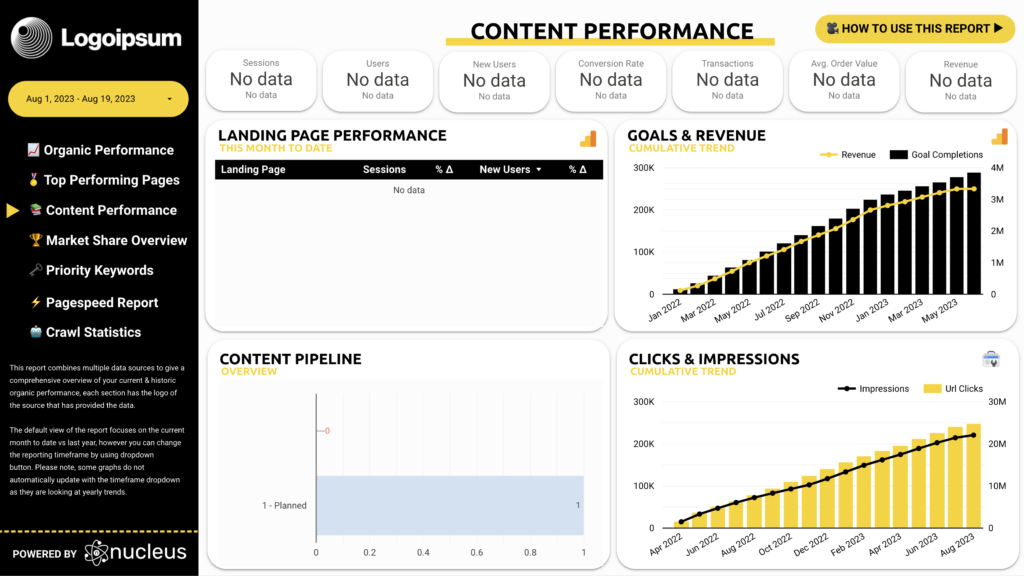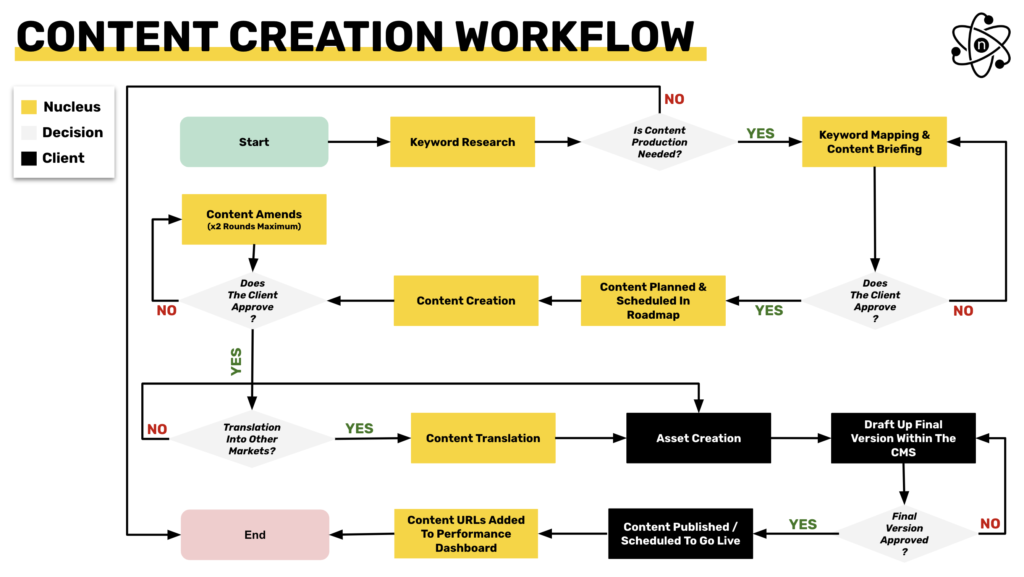Great content is engaging and informative, leaving readers wanting more. While consumers recognise it instantly, creators often grapple with producing it. The secret? Understand your audience’s needs and match their search intent. In today’s competitive digital realm, standout content is paramount. It’s a complex endeavor requiring planning, research, and expertise. At Nucleus, we meld experience with AI and SEO to deliver exceptional content, aiming to drive organic growth for clients. Let’s explore our process further.
The Art of Writing Good Content
Aside from the tried and true E-E-A-T elements that should always accompany any great piece of content, our Nucleus content writers believe there are five fundamental components that also underpin excellent content: relevance, usefulness, originality, clarity, and design.
- Relevance: Aligning your content with the needs and interests of your audience. As an SEO consultancy, we are well-versed in identifying what an audience is searching for, thus ensuring that the content we create for our clients is always highly relevant.
- Usefulness: Go that extra mile. It's not enough for your content to be related to what your audience wants to know; it should also add value by providing solutions to their problems or by delivering insights that they haven't come across elsewhere.
- Originality: Ensure your content is unique and not just a mash-up of existing material. This means delving into original research, offering fresh perspectives, or finding new ways to approach a topic.
- Clarity: Write content that is easy to understand. Jargon and complex language of course have their place, depending on the client and the topic, but as a rule of thumb good content should be accessible to everyone. It’s all about expressing ideas in a simple, direct way that doesn’t sacrifice depth.
- Design: Great content grabs the reader's attention and holds it. This could be through a compelling narrative, an exciting tone, or thought-provoking ideas, but one of the most overlooked elements is the design & formatting of the content. When content is engaging, it encourages an audience to interact with it - to comment, to share, and to return for more.
All of these fundamental principles are underpinned by the role of SEO and keyword research in content creation. Applying SEO practices to content creation is about more than just cramming your content full of keywords – it’s about understanding the nuances of how search engines operate and crafting content that aligns with these principles.
Through our in-depth keyword research process, we’re able to identify not just the words and phrases a target audience is using, but also the questions they’re asking and the problems they’re looking to solve.
Crafting great content is both an art and a science, and at Nucleus, we believe we’ve mastered both.
Using Artificial Intelligence (AI) in Content Creation
We’re living in a time when technology is exponentially evolving, and adaptability and innovation are crucial for any organisation that wants to stay competitive. This is especially true in content creation, where traditional methods are being supplemented – and in some cases, even replaced – by artificial intelligence.
We believe the key to successfully implementing AI into content creation is not to rely on it entirely, and not to avoid it altogether. It’s to instead focus on enhancing your content creation process by creating the right blend of prompts to scale and streamline content creation. All while ensuring quality control through human expertise to align the output with a client’s tone of voice and a project’s goals.
At Nucleus, we do this by leveraging AI tools like ChatGPT and DeepL to enhance our content creation process. We use ChatGPT for brainstorming ideas, drafting content outlines and even to get suggestions for improving texts, which in turn allows us to focus on strategic, high-level tasks while efficiently scaling our content production. Similarly, using the AI-based translation tool DeepL allows us to scale high-quality mass-translations for clients operating in multiple markets.
See how we used both ChatGPT and DeepL to create over 600 unique category texts for our client Polarn O. Pyret.
Using AI has numerous benefits – first, it increases our team’s efficiency. By automating the more repetitive aspects of content creation, we’re able to produce high-quality content faster and more consistently. This brings us to the second benefit, scalability. With AI, we can generate a much larger volume of content without compromising quality, which allows us to cater to a broader range of client needs and adapt quickly to market changes.
The third benefit is relevance. AI tools like ChatGPT are able to use vast amounts of data to understand and predict the evolving interests of a client’s target audience. This, combined with our team’s quality control measures, ensures that the content we produce is always relevant and engaging.
Adapting and innovating our processes allows us to stay ahead of the curve. By incorporating the use of AI into our content creation process, we at Nucleus can provide our clients with superior, personalised content that sets them apart from their competitors. AI isn’t just the future of content creation – it’s the present.
Bringing Art & Science Together (6 Step Process)
As we know, creating great content isn’t just about the end result. It’s a process that begins with understanding the client’s needs, and ends with a polished, optimized, and engaging final product. Here’s an overview of what that process looks like for us at Nucleus.
Step 1: Keyword Research
Did you know that more than 90% of content on the internet gets zero traffic through Google? So how do we avoid creating content that will never see the light of day? Intent is everything! Understanding what our clients’ audience is actually looking for, and how they’re looking for it, is and always will be step number one for us at Nucleus when it comes to content strategising and creation.
Step 2: Crafting a Content Strategy
Note: Nucleus Template Example
Based on the findings from our keyword research, our next step is to create a content roadmap where we outline how many pieces, what types of content should be created (and when) along with how they should be internally linked into priority pages in order to achieve the client’s end goals.
Step 3: Creating The Content
With a data-backed strategy now in place, we are ready to start creating our content! Our writers begin with their in-depth research processes, delving into key ideas, and adhering to E-E-A-T principles and those previously-mentioned key fundamental concepts that make for excellent content. AI-tools may be incorporated at this stage to draft outlines for articles, scale the production of category texts or check language translation accuracy, depending on the specific project. During this process, we make suggestions on how the content should be formatted within the client’s CMS to encourage engagement.
Step 4: Content Translation (When Relevant)
Some of our clients operate across different markets and need content produced in multiple languages. At this stage, we use a blend of AI-tools & local market teams to translate our newly produced content into the relevant languages for our client. The efficiency and accuracy of our AI-tools combined with local market knowledge lets us scale translations without compromising on quality.
Step 5: Client Review and Feedback
Nucleus’ proprietary documents and spreadsheets encourage full collaboration between ourselves and our clients – once a piece of content has been written, edited, translated and is ready for review, our clients are able to instantly access the piece directly within our shared documents. We then address any client feedback within a short turnaround time, ensuring that the relevant edits and adjustments are swiftly implemented.
Step 6: Performance Tracking

Note: Nucleus Template Example
Finished? Not quite! The final step is to continuously monitor the performance of our newly created and published pieces. By tracking their performance and again relying on data-backed information, we’re able to evaluate how well the content is accurately meeting the audience’s search intent, and can determine how this performance impacts our clients’ overall business goals.
What Makes Our Process Unique?
We’ve designed our content process to stand out from the crowd.
- Customisation & Collaboration: Each business has unique needs and goals. That's why we never adopt a one-size-fits-all approach. Instead, we tailor our process to each client, customising our strategies to align with their specific objectives. What's more, we believe in a collaborative process where the client is involved in every stage, ensuring their tone of voice, messaging and values are reflected through the content we create for them.
- Data-Backed Methods: We're driven by data. Our process relies on extensive keyword research and performance metrics, enabling us to create content that aims to precisely meet search intent. This ensures that our content not only resonates with the target audience but also performs well in search engine rankings.
- Integration of AI: In an ever-evolving digital landscape, we stay ahead by integrating AI into our process. By leaning into and adopting new technologies, we’re able to streamline our workflow, enhance efficiency, and keep our clients’ content relevant.
- Quality Assurance: We don't compromise on quality. Every piece of content that we produce undergoes a dedicated creation and review process, ensuring that it's not just top-notch, but also SEO-friendly, reader-friendly, and aligned with our clients’ end-goals.
The Future of Content Creation
At Nucleus, we see content creation as both an art and a science, where fundamental principles of great writing meet innovative use of technology, data, and bespoke collaboration. With the integration of AI tools like ChatGPT and DeepL, we’re able to scale projects, stay relevant, and enhance efficiency without compromising on quality – all to keep providing our clients with top-quality content. Our dynamic process mirrors our belief in the uniqueness of each client’s needs and our commitment to deliver superior, SEO-tailored content.



